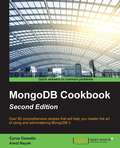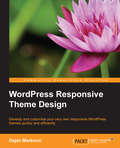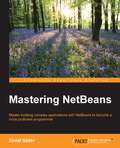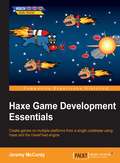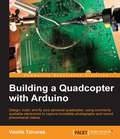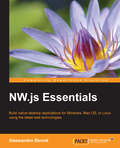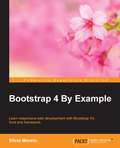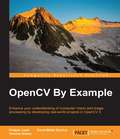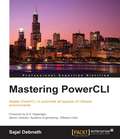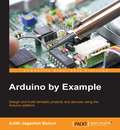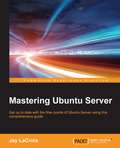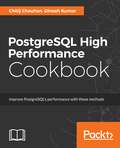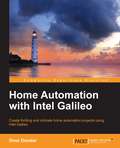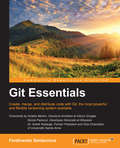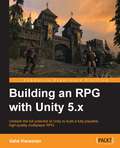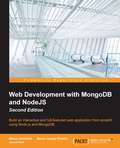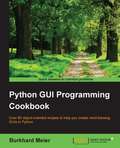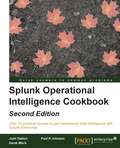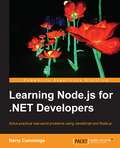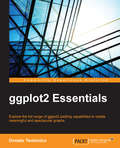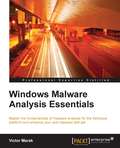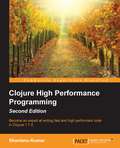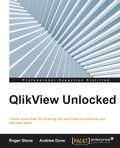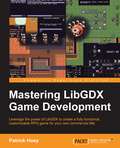- Table View
- List View
MongoDB Cookbook - Second Edition
by Amol Nayak Cyrus DasadiaHarness the latest features of MongoDB 3 with this collection of 80 recipes - from managing cloud platforms to app development, this book is a vital resourceAbout This BookGet to grips with the latest features of MongoDB 3Interact with the MongoDB server and perform a wide range of query operations from the shellFrom administration to automation, this cookbook keeps you up to date with the world's leading NoSQL databaseWho This Book Is ForThis book is engineered for anyone who is interested in managing data in an easy and efficient way using MongoDB. You do not need any prior knowledge of MongoDB, but it would be helpful if you have some programming experience in either Java or Python.What You Will LearnInstall, configure, and administer MongoDB sharded clusters and replica setsBegin writing applications using MongoDB in Java and Python languagesInitialize the server in three different modes with various configurationsPerform cloud deployment and introduce PaaS for MongoDiscover frameworks and products built to improve developer productivity using MongoTake an in-depth look at the Mongo programming driver APIs in Java and PythonSet up enterprise class monitoring and backups of MongoDBIn DetailMongoDB is a high-performance and feature-rich NoSQL database that forms the backbone of the systems that power many different organizations - it's easy to see why it's the most popular NoSQL database on the market. Packed with many features that have become essential for many different types of software professionals and incredibly easy to use, this cookbook contains many solutions to the everyday challenges of MongoDB, as well as guidance on effective techniques to extend your skills and capabilities.This book starts with how to initialize the server in three different modes with various configurations. You will then be introduced to programming language drivers in both Java and Python. A new feature in MongoDB 3 is that you can connect to a single node using Python, set to make MongoDB even more popular with anyone working with Python. You will then learn a range of further topics including advanced query operations, monitoring and backup using MMS, as well as some very useful administration recipes including SCRAM-SHA-1 Authentication. Beyond that, you will also find recipes on cloud deployment, including guidance on how to work with Docker containers alongside MongoDB, integrating the database with Hadoop, and tips for improving developer productivity.Created as both an accessible tutorial and an easy to use resource, on hand whenever you need to solve a problem, MongoDB Cookbook will help you handle everything from administration to automation with MongoDB more effectively than ever before.Style and approachEvery recipe is explained in a very simple set-by-step manner yet is extremely comprehensive.
WordPress Responsive Theme Design
by Dejan MarkovicIf you are a WordPress enthusiast who wants to develop and customize your own responsive WordPress theme, this book is for you. Some experience with WordPress, HTML, PHP, and CSS is expected and highly recommended.
Mastering NetBeans
by David SalterIf you are a competent developer who wants to fast-track your application development with NetBeans IDE, then this book is for you. Reasonable knowledge and an understanding of Java programming and NetBeans IDE is assumed.
Haxe Game Development Essentials
by Jeremy MccurdyCreate games on multiple platforms from a single codebase using Haxe and the HaxeFlixel engine About This Book * Learn the modern, cross-platform language Haxe to build games without any trouble * Create engaging 2D games that are compatible with desktop, web, and mobile platforms * Learn how to speed up your workflow with OpenFL and HaxeFlixel using this useful and compact guide Who This Book Is For This book is for game developers with some experience programming games on one or more platforms already. If you want to leverage your game development experience on one platform to develop for multiple platforms and to get up and running quickly, this book is for you. Having prior experience with a language similar to Haxe, such as ActionScript or JavaScript will help, but isn't required. What You Will Learn * Understand the fundamentals of the Haxe programming language * Set up a development environment that will work on Windows, Mac, and Linux * Create fun 2D games using OpenFL and HaxeFlixel * Understand how to implement a user interface * Enhance the gameplay experience with cool animations * Improve immersion by adding sound * Make your game modular and easily expandable using configuration files * Compile games that will work on desktop, web, and mobile platforms In Detail Haxe is a powerful and high-level multi-platform language that's incredibly easy to learn. Used by thousands of developers and many high-profile companies, Haxe is quickly emerging as a forerunner in the area of cross-platform programming. OpenFL builds on top of Haxe to make developing for multiple platforms quick and painless. HaxeFlixel provides you with the tools you need to build amazing 2D games easier than ever before. Cross-platform development has been supercharged using the Haxe programming language, making it increasingly easy and hassle-free to develop multi-platform games. If you've programmed games before and want to learn out how to deliver games across multiple platforms, or develop games faster, then Haxe Game Development Essentials is the book for you. It starts by showing you how to set up your development environment, then running you through some Haxe language fundamentals, and finally taking you through the process of programming a game from start to finish. You will learn how to create a side scrolling shooter game using HaxeFlixel. Next you will learn to enhance the game with new gameplay features, user interfaces, animations, sound, and configuration files to make your game expandable. Once your game is built and ready, you will learn how to deploy it to web, Android, iOS, and desktop systems. By the end of this book, you will be confident about creating multi-platform games using Haxe, OpenFL, and HaxeFlixel in a faster and easier way. Style and approach Since this book is aimed at people who have worked on games before, this book is written in a way that will get you quickly up to speed with a new set of tools, but will still be accessible for less experienced developers. Each chapter covers an essential milestone in building a game from start to finish. The chapters move in a logical fashion, starting with the basics of Haxe development and ending with preparing a game for deployment.
Building a Quadcopter with Arduino
by Vasilis TzivarasDesign, build, and fly your personal quadcopter using market electronics to capture incredible photographs and record phenomenal videosAbout This BookGrasp the knowledge required to assemble your drone with light and cost effective materialsEnlighten your understanding about the flight by performing step-by-step pre-flight adjustments and acquiring the instructions for a safe flightGet the best tips to deal with performance issues related to your quadcopterWho This Book Is ForThis book is intended for hobbyists who are looking forward to fulfill their dream of flying a quadcopter clearly made by them. Some basic experience in electronic circuits and aerial vehicles will make it easier for you, however it isn't mandatory.What You Will LearnReview and choose the most suitable material for the buildSet up and calibrate all of your electronic partsControl and fly your quadcopter taking into account the weather conditionsMaintain your vehicle as much as possible and repair it whenever requiredEngineer the structure of your vehicleDevelop a flight controller with its basic principlesEliminate possible malfunctions in the futureRepair your drone if it crashes or faces any damageIn DetailQuadcopters, also known as quadrotors, are gaining more and more popularity in today's world. With the help of these devices, anyone can have an "eye in the sky" and can monitor any place at any time. You can capture photographs and once a while and perform automated tasks. In this book, you will be informed about all the basic modules and electronics needed to fly a simple quadcopter. You'll delve deep to create a fully-functional quadcopter quickly with the help of Arduino boards. Through this book, you'll develop the skills needed to build a DIY drone that can capture pictures and record videos.Style and approachThis is an easy-to-follow guide with pictorial depictions and technical descriptions to assemble your vehicle.
NW.js Essentials
by Alessandro BenoitIf you are an experienced Node.js developer who wants to create amazing desktop applications using NW.js, this is the book for you. Prior knowledge of HTML5, jQuery, and CSS is assumed.
Bootstrap By Example
by Silvio MoretoMaster Bootstrap 4's frontend framework and build your websites faster than ever before About This Book * Become an expert in Bootstrap framework, and speed up front-end development and prototyping through real-life examples * An applied guide exploring two web applications such as Twitter and Dashboard from scratch * Hands on the Bootstrap version 4 even before the official release Who This Book Is For If you are a frontend developer with no knowledge of Bootstrap, then this book is for you. Basic knowledge of HTML, CSS, and JavaScript is expected, as well as a reasonable understanding of web frameworks, such as jQuery. What You Will Learn * Discover how to use Bootstrap's components and elements, and to customize them for your own projects * Understand the framework's usage in the best way with the recommended development patterns * Create web pages for any kind of device like tablet, mobile, computer, etc. * Construct a Twitter app by exploring the advanced bootstrap components like Breadcrumbs, Pagination, Media objects, and so on * Combine the power of JavaScript with your Bootstrap app for more functionality * Create a Dashboard web app using Bootstrap's JavaScript plugins * Learn the difference between Bootstrap's version 3 and 4 of the framework * Extend your knowledge on Bootstrap's external plugins, their incorporation and usage In Detail Bootstrap is a free, open source collection of tools that helps developers create websites or web applications. It provides a faster, easier, and less repetitive solution to designing and building applications. Before Bootstrap's release, it was necessary to import a variety of libraries into your project that offered different components and features for web interface development. Plus with the increased popularity of smartphones there were lack of libraries that could handle the responsiveness of a web page. Bootstrap's existence let it quickly become famous as a front-end framework that offered a wide set of tools from page grid up to components that render a web page in the best possible way for any device. This book will be a tutorial covering various examples as well as step-by-step methodology to create interesting web applications using Bootstrap and to understand the front-end framework to its core. We begin with an introduction to the Bootstrap framework and setting up an environment to build a simple web page. We then cover the grid system, basic Bootstrap components, HTML elements, and customization components for responsive and mobile first development. This is presented by creating a beautiful Landing page sample. You will also learn how to create a web application like Twitter by using the full set of components offered in the framework. Finally, you will learn to create a dashboard web app, using Bootstrap to its finest potential including component customizations, event handling, and external library integration. All these examples are explained step-by-step and in depth, while covering the versions 3 and the most recent version 4 of Bootstrap. So, you will be in the state of the art for front-end development. By the end of this book, you will be familiar with the development of a plugin for the framework and Bootstrap's world which is popular for fast paced front-end web development, used in countless projects all over the world, and now yours. Style and approach This is a step-by-step guide that closely focuses on developing web applications in most objective way solving real-life problems with Bootstrap. It covers two sample web applications, which are explained in detail.
OpenCV By Example
by Prateek Joshi David Millan Escriva Vinicius GodoyEnhance your understanding of Computer Vision and image processing by developing real-world projects in OpenCV 3 About This Book * Get to grips with the basics of Computer Vision and image processing * This is a step-by-step guide to developing several real-world Computer Vision projects using OpenCV 3 * This book takes a special focus on working with Tesseract OCR, a free, open-source library to recognize text in images Who This Book Is For If you are a software developer with a basic understanding of Computer Vision and image processing and want to develop interesting Computer Vision applications with Open CV, this is the book for you. Knowledge of C++ is required. What You Will Learn * Install OpenCV 3 on your operating system * Create the required CMake scripts to compile the C++ application and manage its dependencies * Get to grips with the Computer Vision workflows and understand the basic image matrix format and filters * Understand the segmentation and feature extraction techniques * Remove backgrounds from a static scene to identify moving objects for video surveillance * Track different objects in a live video using various techniques * Use the new OpenCV functions for text detection and recognition with Tesseract In Detail Open CV is a cross-platform, free-for-use library that is primarily used for real-time Computer Vision and image processing. It is considered to be one of the best open source libraries that helps developers focus on constructing complete projects on image processing, motion detection, and image segmentation. Whether you are completely new to the concept of Computer Vision or have a basic understanding of it, this book will be your guide to understanding the basic OpenCV concepts and algorithms through amazing real-world examples and projects. Starting from the installation of OpenCV on your system and understanding the basics of image processing, we swiftly move on to creating optical flow video analysis or text recognition in complex scenes, and will take you through the commonly used Computer Vision techniques to build your own Open CV projects from scratch. By the end of this book, you will be familiar with the basics of Open CV such as matrix operations, filters, and histograms, as well as more advanced concepts such as segmentation, machine learning, complex video analysis, and text recognition. Style and approach This book is a practical guide with lots of tips, and is closely focused on developing Computer vision applications with OpenCV. Beginning with the fundamentals, the complexity increases with each chapter. Sample applications are developed throughout the book that you can execute and use in your own projects.
Mastering PowerCLI
by Sajal DebnathMaster PowerCLI to automate all aspects of VMware environments About This Book * Leverage PowerCLI to perform administration tasks in a more effective and efficient way * Escape from daily tedious and repetitive tasks by unleashing the full potential of your creative side through scripting * Master the intricate workings of PowerShell and PowerCLI through easy and real-life examples Who This Book Is For If you are a system administrator with working knowledge of PowerShell and PowerCLI who wants to perform quick and easy scripting but at the same time achieve complex results and write production grade scripts, then this book is for you. What You Will Learn * Use GitHub for collaboration and Pester to automate unit tests * Write advanced reusable functions and dynamic variables and learn about error handling in PowerShell * Automate ESXi host installation using Auto-Deploy, host profile, and host image * Implement security best practices in a vSphere data center * Manage SRM, vCloud Air, and vRealize Operations environments * Access and utilize vSphere APIs to manage advanced aspects of vSphere and work with .NET view objects * Utilize REST APIs to manage vRealize Automation environments * Create a Windows GUI through the use of PowerShell and Sapien PrimalForms CE In Detail Have you ever wished that every morning you could automatically get a report with all the relevant information about your datacenter in exactly the same format you want? Or whether you could automate that boring, exhausting task? What if some crucial task needs to be performed on a regular basis without any error? PowerCLI scripts do all that and much more for VMware environments. It is built on top of the popular Windows PowerShell, with which you can automate server tasks and reduce manual input, allowing you to focus on more important tasks. This book will help you to achieve your goals by starting with a short refresher on PowerShell and PowerCLI and then covering the nuances of advanced functions and reusable scripts. Next you will learn how to build a vSphere-powered virtualized datacenter using PowerCLI while managing different aspects of the environment including automated installation, network, and storage. You will then manage different logical constructs of vSphere environment and different aspects of a virtual machine. Later, you will implement the best practices for a security implementation in vSphere Environment through PowerCLI before discovering how to manage other VMware environments such as SRM, vCloud Director and vCloud Air through PowerCLI. You will also learn to manage vSphere environments using advanced properties by accessing vSphere API and REST APIs through PowerCLI. Finally, you will build a Windows GUI application using PowerShell followed by a couple of sample scripts for reporting and managing vSphere environments with detailed explanations of the scripts. By the end of the book, you will have the required in-depth knowledge to master the art of PowerCLI scripting. Style and approach In this book, every topic is explained in a very easy-to-follow fashion with real-life, simple examples so that you get an idea of not only the topic but also the context in which it should be used or where it can be best utilized.
Arduino by Example
by Adith Jagadish BoloorDesign and build fantastic projects and devices using the Arduino platform About This Book * Explore the different sensors that can be used to improve the functionality of the Arduino projects * Program networking modules in conjunction with Arduino to make smarter and more communicable devices * A practical guide that shows you how to utilize Arduino to create practical, useful projects Who This Book Is For This book is an ideal choice for hobbyists or professionals who want to create quick and easy projects with Arduino. As a prerequisite, readers must have a working Arduino system and some programming background, ideally in C/C++. Basic knowledge of Arduino is helpful but not required to follow along with this book. What You Will Learn * Understand and utilize the capabilities of the Arduino * Integrate sensors to gather environmental data and display this information in meaningful ways * Add modules such as Bluetooth and Wi-fithat allow the Arduino to communicate and send data between devices * Create simple servers to allow communication to occur * Build automated projects including robots while learning complex algorithms to mimic biological locomotion * Implement error handling to make programs easier to debug and look more professional * Integrate powerful programming tools and software such as Python and Processing to broaden the scope of what the Arduino can achieve * Practice and learn basic programming etiquette In Detail Arduino an opensource physical computing platform based on a simple microcontroller board, and a development environment for writing software for the board. The opensource Arduino software (IDE) makes it easy to write code and upload it to the board. It runs on Windows, Mac OS X, and Linux. The environment is written in Java and based on Processing and other opensource software. With the growing interest in home-made, weekend projects among students and hobbyists alike, Arduino offers an innovative and feasible platform to create projects that promote creativity and technological tinkering. Arduino by Example is a project-oriented guide to help you fully utilize the power of one of the world's most powerful open source platforms, Arduino. This book demonstrates three projects ranging from a home automation project involving your lighting system to a simple robotic project to a touch sensor project. You will first learn the basic concepts such as how to get started with the Arduino, and as you start building the project, you will develop the practical skills needed to successfully build Arduino powered projects that have real-life implications. The complexity of the book slowly increases as you complete a project and move on to the next. By the end of this book, you will be able to create basic projects and utilize the elements used in the examples to construct your own devices. Style and approach This book follows a project-oriented approach, with multiple images and plenty of code to help you build your projects easily. The book uses a tutorial-based methodology where the concepts are first explained and then implemented to help you develop the projects.
Mastering Ubuntu Server
by Jay LacroixGet up to date with the finer points of Ubuntu Server using this comprehensive guide About This Book * Get well-versed with newly-added features in Ubuntu 16.04 * Master the art of installing, managing, and troubleshooting Ubuntu Server * A practical easy-to-understand book that will help you enhance your existing skills. Who This Book Is For This book is intended for readers with intermediate or advanced-beginner skills with Linux, who would like to learn all about setting up servers with Ubuntu Server. This book assumes that the reader knows the basics of Linux, such as editing configuration files and running basic commands. What You Will Learn * Learn how to manage users, groups, and permissions * Encrypt and decrypt disks with Linux Unified Key Setup /Luks * Setup SSH for remote access, and connect it to other nodes * Understand how to add, remove, and search for packages * Use NFS and Samba to share directories with other users * Get to know techniques for managing Apache and MariaDB * Explore best practices and troubleshooting techniques In Detail Ubuntu is a Debian-based Linux operating system, and has various versions targeted at servers, desktops, phones, tablets and televisions. The Ubuntu Server Edition, also called Ubuntu Server, offers support for several common configurations, and also simplifies common Linux server deployment processes. With this book as their guide, readers will be able to configure and deploy Ubuntu Servers using Ubuntu Server 16.04, with all the skills necessary to manage real servers. The book begins with the concept of user management, group management, as well as file-system permissions. To manage your storage on Ubuntu Server systems, you will learn how to add and format storage and view disk usage. Later, you will also learn how to configure network interfaces, manage IP addresses, deploy Network Manager in order to connect to networks, and manage network interfaces. Furthermore, you will understand how to start and stop services so that you can manage running processes on Linux servers. The book will then demonstrate how to access and share files to or from Ubuntu Servers. You will learn how to create and manage databases using MariaDB and share web content with Apache. To virtualize hosts and applications, you will be shown how to set up KVM/Qemu and Docker and manage virtual machines with virt-manager. Lastly, you will explore best practices and troubleshooting techniques when working with Ubuntu Servers. By the end of the book, you will be an expert Ubuntu Server user well-versed in its advanced concepts. Style and Approach This book is an advanced guide that will show readers how to administer, manage, and deploy Ubuntu server and will also provide expert-level knowledge on advanced security and backup techniques.
PostgreSQL High Performance Cookbook
by Chitij Chauhan Dinesh KumarGet to know effective ways to improve PostgreSQL's performance and master query optimization, and database monitoring. About This Book • Perform essential database tasks such as benchmarking the database and optimizing the server's memory usage • Learn ways to improve query performance and optimize the PostgreSQL server • Explore a wide range of high availability and replication mechanisms to build robust, highly available, scalable, and fault-tolerant PostgreSQL databases Who This Book Is For If you are a developer or administrator with limited PostgreSQL knowledge and want to develop your skills with this great open source database, then this book is ideal for you. Learning how to enhance the database performance is always an exciting topic to everyone, and this book will show you enough ways to enhance the database performance. What You Will Learn • Build replication strategies for homogeneous and heterogeneous databases • Test and build a powerful machine with multiple bench marking techniques • Get to know a few SQL injection techniques • Find out how to manage the replication using multiple tools • Benchmark the database server using multiple strategies • Work with the query processing algorithms and their internal behaviors • Build a proper plan to upgrade or migrate to PostgreSQL from other databases • See the essential database load balancing techniques and the various partitioning approaches PostgreSQL provides • Learn memory optimization techniques and database server configurations In Detail PostgreSQL is one of the most powerful and easy to use database management systems. It has strong support from the community and is being actively developed with a new release every year. PostgreSQL supports the most advanced features included in SQL standards. It also provides NoSQL capabilities and very rich data types and extensions. All of this makes PostgreSQL a very attractive solution in software systems. If you run a database, you want it to perform well and you want to be able to secure it. As the world's most advanced open source database, PostgreSQL has unique built-in ways to achieve these goals. This book will show you a multitude of ways to enhance your database's performance and give you insights into measuring and optimizing a PostgreSQL database to achieve better performance. This book is your one-stop guide to elevate your PostgreSQL knowledge to the next level. First, you'll get familiarized with essential developer/administrator concepts such as load balancing, connection pooling, and distributing connections to multiple nodes. Next, you will explore memory optimization techniques before exploring the security controls offered by PostgreSQL. Then, you will move on to the essential database/server monitoring and replication strategies with PostgreSQL. Finally, you will learn about query processing algorithms. Style and approach This comprehensive guide is packed with practical administration tasks. Each topic is explained using examples and a step-by-step approach.
Home Automation with Intel Galileo
by Onur DundarThis book is for anyone who wants to learn Intel Galileo for home automation and cross-platform software development. No knowledge of programming with Intel Galileo is assumed, but knowledge of the C programming language is essential.
Git Essentials
by Ferdinando SantacroceIf you are a software developer with little or no experience of versioning systems, or are familiar with other centralized versioning systems, then this book is for you. If you have some experience working with command lines or using Linux admin or just using Unix and want to know more about Git, then this book is ideal for you.
Building an RPG with Unity 5.x
by Vahe KaramianUnleash the full potential of Unity to build a fully playable, high-quality multiplayer RPG About This Book * Learn to build a multiplayer real-time strategy game from scratch using Unity * Gain knowledge of Unity's UI system to build complex user interfaces * See how to build and customize your framework for your RPG games Who This Book Is For If you have always wanted to create a high-end RPG using Unity, then this book is for you. Prior knowledge of game development is required and experience working with Unity will be beneficial. What You Will Learn * Construct a framework for inventory, equipment, characters, enemies, quests, and game events * See how to load and unload scenes and assets * Create multiplayer game settings for our RPG * Design a UI for user input and feedback * Enhance Game Master to handle all aspects of the RPG * Develop a custom pathfinding system * Implement AI for character and non-character players In Detail Unity is one of the most cutting-edge game engines in the world. Developers are looking for the best ways to create games of any genre in the engine. This comprehensive guide on building an RPG with Unity teaches you high-end techniques currently used in developing modern games - the tips, tricks, and techniques can be applied to your own role RPG. We begin with an introduction to, and the fundamentals of, RPG games. Moving further, you will learn the necessary parts of building an RPG, such as structuring the game environment, customizing characters, controlling the camera, and designing other attributes like inventory, weapons, and so on. We also cover designing levels of the game by adding more features to it and making the game more interesting. You will also learn how to get around the obstacle of networking in Unity and be able to implement Multi-Player mode for your RPG games. By the end of the book, you will be able to build upon core the RPG framework elements to create your own game experience. Style and approach This step-by-step tutorial will teach you how to build a multiplayer RPG. In this book you will explore the core concepts of what typical strategy one might need to build a complete game.
Web Development with MongoDB and NodeJS - Second Edition
by Jason Krol Mithun Satheesh Bruno Joseph D'MelloBuild an interactive and full-featured web application from scratch using Node.js and MongoDBAbout This BookConfigure your development environment to use Node.js and MongoDBUse Node.js to connect to a MongoDB database and perform data manipulationsA practical guide with clear instructions to design and develop a complete web application from start to finishWho This Book Is ForThis book is designed for JavaScript developers of any skill level that want to get up and running using Node.js and MongoDB to build full-featured web applications. A basic understanding of JavaScript and HTML is the only requirement for this book.What You Will LearnConfigure your development environment to use Node.js and MongoDBWrite and configure a web server using Node.js powered by the Express.js frameworkBuild dynamic HTML pages using the Handlebars template enginePersist application data using MongoDB and Mongoose ODMTest your code using automated testing tools such as the Mocha frameworkDeploy the development environment to the cloud using services such as Heroku, Amazon Web Services, and Microsoft AzureExplore Single-Page application frameworks to take your web applications to the next levelIn DetailNode.js and MongoDB are quickly becoming one of the most popular tech stacks for the web. Powered by Google's V8 engine, Node.js caters to easily building fast, scalable network applications while MongoDB is the perfect fit as a scalable, high-performance, open source NoSQL database solution. Using these two technologies together, web applications can be built quickly and easily and deployed to the cloud with very little difficulty.The book will begin by introducing you to the groundwork needed to set up the development environment. Here, you will quickly run through the steps necessary to get the main application server up and running. Then you will see how to use Node.js to connect to a MongoDB database and perform data manipulations.From here on, the book will take you through integration with third-party tools for interaction with web apps. It then moves on to show you how to use controllers and view models to generate reusable code that will reduce development time. Toward the end of the book, we will cover tests to properly execute the code and some popular frameworks for developing web applications.By the end of the book, you will have a running web application developed with MongoDB and Node.js along with it's popular frameworks.Style and approachAn easy guide to Node.js and MongoDB, which will quickly introduce you to the relevant concepts by taking you through the different steps involved in building a full-fledged web application.
Python GUI Programming Cookbook
by Burkhard A. MeierOver 80 object-oriented recipes to help you create mind-blowing GUIs in Python About This Book * Use object-oriented programming to develop amazing GUIs in Python * Create a working GUI project as a central resource for developing your Python GUIs * Packed with easy-to-follow recipes to help you develop code using the latest released version of Python Who This Book Is For If you are a Python programmer with intermediate level knowledge of GUI programming and want to learn how to create beautiful, effective, and responsive GUIs using the freely available Python GUI frameworks, this book is for you. What You Will Learn * Create amazing GUIs with Python's built-in Tkinter module * Customize the GUIs by using layout managers to arrange the GUI widgets * Advance to an object-oriented programming style using Python * Develop beautiful charts using the free Matplotlib Python module * Use threading in a networked environment to make the GUIs responsive * Discover ways to connect the GUIs to a database * Understand how unit tests can be created and internationalize the GUI * Extend the GUIs with free Python frameworks using best practices In Detail Python is a multi-domain, interpreted programming language. It is a widely used general-purpose, high-level programming language. It is often used as a scripting language because of its forgiving syntax and compatibility with a wide variety of different eco-systems. Its flexible syntax enables developers to write short scripts while at the same time, they can use object-oriented concepts to develop very large projects. Python GUI Programming Cookbook follows a task-based approach to help you create beautiful and very effective GUIs with the least amount of code necessary. This book uses the simplest programming style, using the fewest lines of code to create a GUI in Python, and then advances to using object-oriented programming in later chapters. If you are new to object-oriented programming (OOP), this book will teach you how to take advantage of the OOP coding style in the context of creating GUIs written in Python. Throughout the book, you will develop an entire GUI application, building recipe upon recipe, connecting the GUI to a database. In the later chapters, you will explore additional Python GUI frameworks, using best practices. You will also learn how to use threading to ensure your GUI doesn't go unresponsive. By the end of the book, you will be an expert in Python GUI programming to develop a common set of GUI applications. Style and approach Every recipe in this programming cookbook solves a problem you might encounter in your programming career. At the same time, most of the recipes build on each other to create an entire, real-life GUI application.
Splunk Operational Intelligence Cookbook - Second Edition
by Paul R Johnson Josh Diakun Derek MockOver 70 practical recipes to gain operational data intelligence with Splunk Enterprise About This Book * This is the most up-to-date book on Splunk 6.3 and teaches you how to tackle real-world operational intelligence scenarios efficiently * Get business insights using machine data using this easy-to-follow guide * Search, monitor, and analyze your operational data skillfully using this recipe-based, practical guide Who This Book Is For This book is intended for users of all levels who are looking to leverage the Splunk Enterprise platform as a valuable operational intelligence tool. The recipes provided in this book will appeal to individuals from all facets of business, IT, security, product, marketing, and many more! Also, existing users of Splunk who want to upgrade and get up and running with Splunk 6.3 will find this book invaluable. What You Will Learn * Use Splunk to gather, analyze, and report on data * Create dashboards and visualizations that make data meaningful * Build an operational intelligence application with extensive features and functionality * Enrich operational data with lookups and workflows * Model and accelerate data and perform pivot-based reporting * Build real-time, scripted, and other intelligence-driven alerts * Summarize data for longer term trending, reporting, and analysis * Integrate advanced JavaScript charts and leverage Splunk's API In Detail Splunk makes it easy for you to take control of your data, and with Splunk Operational Cookbook, you can be confident that you are taking advantage of the Big Data revolution and driving your business with the cutting edge of operational intelligence and business analytics. With more than 70 recipes that demonstrate all of Splunk's features, not only will you find quick solutions to common problems, but you'll also learn a wide range of strategies and uncover new ideas that will make you rethink what operational intelligence means to you and your organization. You'll discover recipes on data processing, searching and reporting, dashboards, and visualizations to make data shareable, communicable, and most importantly meaningful. You'll also find step-by-step demonstrations that walk you through building an operational intelligence application containing vital features essential to understanding data and to help you successfully integrate a data-driven way of thinking in your organization. Throughout the book, you'll dive deeper into Splunk, explore data models and pivots to extend your intelligence capabilities, and perform advanced searching to explore your data in even more sophisticated ways. Splunk is changing the business landscape, so make sure you're taking advantage of it. Style and approach Splunk is an excellent platform that allows you to make sense of machine data with ease. The adoption of Splunk has been huge and everyone who has gone beyond installing Splunk wants to know how to make most of it. This book will not only teach you how to use Splunk in real-world scenarios to get business insights, but will also get existing Splunk users up to date with the latest Splunk 6.3 release.
Learning Node.js for .NET Developers
by Harry CummingsSolve practical real-world problems using JavaScript and Node.js About This Book * Learn the concepts of Node.js to gain a high-level understanding of the Node.js execution model * Build an interactive web application with MongoDB and Redis and create your own JavaScript modules that work both on the client side and server side * Familiarize yourself with the new features of Node.js and JavaScript with this exclusive step-by-step guide Who This Book Is For This book is for developers who want to learn JavaScript and Node.js. Previous experience with programming is desired, but no JavaScript or Node.js knowledge is required. The book focuses mostly on web development, such as networking, serving dynamic pages, and real-time client-server communication. What You Will Learn * Understand which problems Node.js best solves * Write idiomatic JavaScript and Node.js code * Build web applications and command-line tools * Minimise complexity and efficiently solve difficult problems * Test and deploy Node.js applications * Work with persistent data * Implement real-time client-server applications * Integrate .NET and Node.js code In Detail Node.js is an open source, cross-platform runtime environment that allows you to use JavaScript to develop server-side web applications. This short guide will help you develop applications using JavaScript and Node.js, leverage your existing programming skills from .NET or Java, and make the most of these other platforms through understanding the Node.js programming model. You will learn how to build web applications and APIs in Node, discover packages in the Node.js ecosystem, test and deploy your Node.js code, and more. Finally, you will discover how to integrate Node.js and .NET code. Style and approach This is a step-by-step and practical guide to Node.js for .Net developers. It covers the fundamentals relating to typical applications. The focus is on providing the practical skills required to develop applications, with a summary of the key concepts covered.
ggplot2 Essentials
by Donato TeutonicoThis book is perfect for R programmers who are interested in learning to use ggplot2 for data visualization, from the basics up to using more advanced applications, such as faceting and grouping. Since this book will not cover the basics of R commands and objects, you should have a basic understanding of the R language.
Clojure for Finance
by Timothy WashingtonIf you're a finance professional who is currently using VBA (Excel) to perform financial calculations and quantitative analysis, and would like to use Clojure instead to improve their efficiency, then this book is for you. Basic knowledge of financial concepts is essential. Basic programming knowledge would also be an added advantage.
Windows Malware Analysis Essentials
by Victor MarakMaster the fundamentals of malware analysis for the Windows platform and enhance your anti-malware skill set About This Book * Set the baseline towards performing malware analysis on the Windows platform and how to use the tools required to deal with malware * Understand how to decipher x86 assembly code from source code inside your favourite development environment * A step-by-step based guide that reveals malware analysis from an industry insider and demystifies the process Who This Book Is For This book is best for someone who has prior experience with reverse engineering Windows executables and wants to specialize in malware analysis. The book presents the malware analysis thought process using a show-and-tell approach, and the examples included will give any analyst confidence in how to approach this task on their own the next time around. What You Will Learn * Use the positional number system for clear conception of Boolean algebra, that applies to malware research purposes * Get introduced to static and dynamic analysis methodologies and build your own malware lab * Analyse destructive malware samples from the real world (ITW) from fingerprinting and static/dynamic analysis to the final debrief * Understand different modes of linking and how to compile your own libraries from assembly code and integrate the codein your final program * Get to know about the various emulators, debuggers and their features, and sandboxes and set them up effectively depending on the required scenario * Deal with other malware vectors such as pdf and MS-Office based malware as well as scripts and shellcode In Detail Windows OS is the most used operating system in the world and hence is targeted by malware writers. There are strong ramifications if things go awry. Things will go wrong if they can, and hence we see a salvo of attacks that have continued to disrupt the normal scheme of things in our day to day lives. This book will guide you on how to use essential tools such as debuggers, disassemblers, and sandboxes to dissect malware samples. It will expose your innards and then build a report of their indicators of compromise along with detection rule sets that will enable you to help contain the outbreak when faced with such a situation. We will start with the basics of computing fundamentals such as number systems and Boolean algebra. Further, you'll learn about x86 assembly programming and its integration with high level languages such as C++.You'll understand how to decipher disassembly code obtained from the compiled source code and map it back to its original design goals. By delving into end to end analysis with real-world malware samples to solidify your understanding, you'll sharpen your technique of handling destructive malware binaries and vector mechanisms. You will also be encouraged to consider analysis lab safety measures so that there is no infection in the process. Finally, we'll have a rounded tour of various emulations, sandboxing, and debugging options so that you know what is at your disposal when you need a specific kind of weapon in order to nullify the malware. Style and approach An easy to follow, hands-on guide with descriptions and screenshots that will help you execute effective malicious software investigations and conjure up solutions creatively and confidently.
Clojure High Performance Programming - Second Edition
by Shantanu KumarBecome an expert at writing fast and high performant code in Clojure 1.7.0 About This Book * Enhance code performance by using appropriate Clojure features * Improve the efficiency of applications and plan their deployment * A hands-on guide to designing Clojure programs to get the best performance Who This Book Is For This book is intended for intermediate Clojure developers who are looking to get a good grip on achieving optimum performance. Having a basic knowledge of Java would be helpful. What You Will Learn * Identify performance issues in Clojure programs using different profiling tools * Master techniques to achieve numerical performance in Clojure * Use Criterium library to measure latency of Clojure expressions * Exploit Java features in Clojure code to enhance performance * Avoid reflection and boxing with type hints * Understand Clojure's concurrency and state-management primitives in depth * Measure and monitor performance, and understand optimization techniques In Detail Clojure treats code as data and has a macro system. It focuses on programming with immutable values and explicit progression-of-time constructs, which are intended to facilitate the development of more robust programs, particularly multithreaded ones. It is built with performance, pragmatism, and simplicity in mind. Like most general purpose languages, various Clojure features have different performance characteristics that one should know in order to write high performance code. This book shows you how to evaluate the performance implications of various Clojure abstractions, discover their underpinnings, and apply the right approach for optimum performance in real-world programs. It starts by helping you classify various use cases and the need for them with respect to performance and analysis of various performance aspects. You will also learn the performance vocabulary that experts use throughout the world and discover various Clojure data structures, abstractions, and their performance characteristics. Further, the book will guide you through enhancing performance by using Java interoperability and JVM-specific features from Clojure. It also highlights the importance of using the right concurrent data structure and Java concurrency abstractions. This book also sheds light on performance metrics for measuring, how to measure, and how to visualize and monitor the collected data. At the end of the book, you will learn to run a performance profiler, identify bottlenecks, tune performance, and refactor code to get a better performance. Style and approach An easy-to-follow guide full of real-world examples and self-sufficient code snippets that will help you get your hands dirty with high performance programming with Clojure.
QlikView Unlocked
by Roger Stone Andrew DoveUnlock more than 50 amazing tips and tricks to enhance your QlikView skillsAbout This BookLearn QlikView development best practices from the expertsDiscover valuable tips, tricks, and undocumented featuresA fast-paced guide with techniques and best practices to optimize high-performance, robust, and scalable applicationsWho This Book Is ForQlikView Unlocked is intended for anyone with at least some experience in designing, developing, or supporting QlikView applications. Whether you are new to QlikView or are a seasoned developer, there is something for everyone in this book.What You Will LearnBuild the QlikView environment correctly so that it is flexible and robustDeliver a successful QlikView projectUnderstand and implement QlikView best practicesDiscover the best way to prototype, develop, and deploy applicationsOvercome data modeling challengesExplore the in's and out's of Section AccessSolve post-deployment issues in Server and PublisherIn DetailQlikView is considered as one of the most used tool for Business Intelligence (BI). An efficient BI tool should provide five important capabilities for effective data analysis--collection (gathering important information), reporting, analysis (the ability to interact with data), visualization (the presentation of data), and discovery (exploring data). QlikView offers all these necessary skills required to deal with big data in real-world scenarios.QlikView Unlocked will provide you with new insights to get the very best from QlikView. This book will help you to develop skills to work with data efficiently. We will cover all the secrets of unleashing the full power of QlikView, which will enable you to make better use of the tool and create better results for future projects.In the course of this book, we will walk you through techniques and best practices that will enable you to be more productive. You will gain quick insights into the tool with the help of short steps called "keys," which will help you discover new features of QlikView. Moving on you will learn new techniques for data visualization, scripting, data modeling, and more. This book will then cover best practices to help you establish an efficient system with improved performance. We will also teach you some tricks that will help you speed up development processes, monitor data with dashboards, and so on.By the end of this book, you will have gained beneficial tips, tricks, and techniques to enhance the overall experience of working with QlikView.Style and approachWritten in a fairly informal style, this is a book that can be read cover-to-cover or simply used as a "how-to" reference. Using real-world examples with clear explanations, code samples, and screenshots, you will be able understand each topic fully. You will be able to apply the knowledge gained to your QlikView projects.
Mastering LibGDX Game Development
by Patrick HoeyLeverage the power of LibGDX to create a fully functional, customizable RPG game for your own commercial title About This Book * Learn game architecture and design patterns with concrete examples using proper software engineering principles * Save time and money with this handy reference guide for future game development with LibGDX * Design and develop a fully functional RPG video game from scratch with a hands on, step-by-step approach using LibGDX Who This Book Is For If you are an intermediate-level game developer who wants to create an RPG video game but found the creation process overwhelming, either by lack of tutorials or by getting lost in a sea of game-related technologies, engines, or frameworks, then this book is for you. This book assumes familiarity with Java and some basic knowledge of LibGDX. What You Will Learn * Develop characters with stat attributes, player movement, animation, physics, and collision detection * Create interactive NPC characters with speech windows and build immersion via dialog trees * Build inventory management system UIs with drag and drop items to sell, buy, and equip * Design a quest system to expand out the content of your game * Form interesting enemies with battle mechanics and spawn points * Devise scripted cutscenes to add an element of story and drama * Develop save and load game profiles * Create special effects to give the game extra "juiciness" and polish, and help build the atmosphere In Detail LibGDX is a Java-based framework developed with a heavy emphasis on performance, and includes cross-platform support out of the box (Windows, OS X, Linux, iOS, Android, and HTML5) as well as providing all the low-level functionality so that you can focus on developing your game and not battling with the platform. LibGDX also has an engaged and responsive community, active maintenance, and is available for free without a prohibitive license. Starting from the beginning, this book will take you through the entire development process of creating an RPG video game using LibGDX. First, this book will introduce you to the features specific to RPG games, as well as an overview of game architecture. Then, you will create map locations, develop character movement, add animation, integrate collision detection, and develop a portal system. Next, you will learn and develop a HUD and other UI components, as well as an inventory management system. You will then develop NPC interactions including dialog trees, shopkeepers, and quest givers. After this, you will design and create battle features for fighting enemies, as well as event triggers for world events. Finally, you will add the final polish with sound, music, and lighting effects. By the end of this book, you will have learned and applied core components from the LibGDX framework, as well as have a finished game to use as a springboard for customization and story development for your own commercial video game. Style and approach This book walks you through the concepts and implementation of developing a complete RPG game, unfolding chapter by chapter and building upon previous concepts. Each chapter can be used as an individual reference with diagrams to explain core concepts with concrete example code explained in detail.
